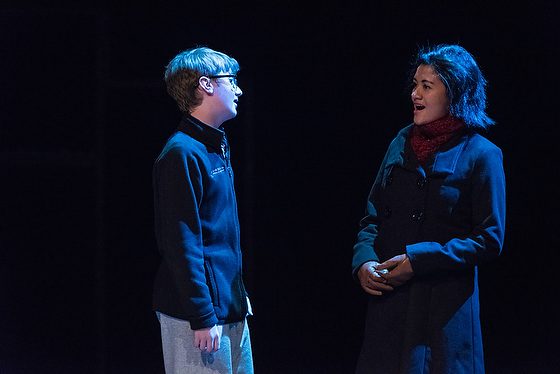| Nikon D750, Sigma 120-300mm ƒ/2.8 DG OS HSM | S, Sigma TC-2001 2x, ISO 12800, ƒ/5.6, 1/200 |
The backlight also called a rim, hair, or shoulder light, shines on the subject from behind, often to one side or the other. It gives the subject a rim of light, separating the subject from the background and highlighting contours.
Not having this light, you can see the difference here in this second photo, where the lighting crew forgot to turn on the backlight.
 |
| Nikon D750, Sigma 120-300mm ƒ/2.8 DG OS HSM | S, ISO 4500, ƒ/2.8, 1/80 |
In one of my master’s classes I took at the Maine Photography Workshop; the instructor always started first with their backlight to create the separation in all his photos. This technique was crucial when he had mixed lighting.
 |
| Nikon D750, Sigma 120-300mm ƒ/2.8 DG OS HSM | S, Sigma TC-2001 2x, ISO 10000, ƒ/5.6, 1/250 |
While in theater, you can see it because often there is a black background; using a backlight helps create depth in your photos. In addition, it helps make those layers from front to back in photographs.
 |
| Nikon D750, Sigma 70-200mm f/2.8 EX DG APO OS HSM, ISO 360, ƒ/2.8, 1/80 |
In theater and most photography, a 3 – point lighting setup is relatively standard.
The backlight can be on the side or directly behind the subject. It is different from a kicker light that catches the sides of the face, for example, in a photo.
 |
| Nikon D750, Sigma 24-105mm f/4 DG OS HSM Art Lens, ISO 100, ƒ/8, 1/60 – 2 Alienbees B1600s for main light |
The sun is the backlight in this photo. The Alienbees studio strobes are the primary or critical light to the camera’s right. The open sky is the fill light.
If you want to create depth, layers, and separation of your subjects from the background, then be sure and use a backlight.
I suggest that is the first light you consider adding to any scene.



